This is a guest post by Charmaine Vaughan, who came to transport advocacy via her local Residents Association and a comms role at Bike Auckland. Her enthusiasm to make local streets safer for all is shared by her son Dylan Vaughan, a budding “urban nerd” who provided much of the research for this post.
Here, they make the case that restricting container trucks from Ngapipi, Kepa, Kohi and St Johns Rd would help make students traveling to school safer, our communities safer, lower congestion on our roads and be better for our environment.
Over 10 years ago, my kids and I would regularly walk or bike over two kilometres to St Thomas Primary School, along St Johns Rd and Kohimarama Rd. This photo captures one of those times. It shows my son on his bike with a container truck on the road right beside him.
Full disclosure: you’ll see at a glance that this image contains some AI generation. But the kid and the bike are very real – as are the container trucks that regularly run along this route.

Did it feel safe? Not really. Did I get used to it over time? Not really. Did the traffic on this road, including container trucks, put other people off letting their children walk and cycle to school? I expect so.
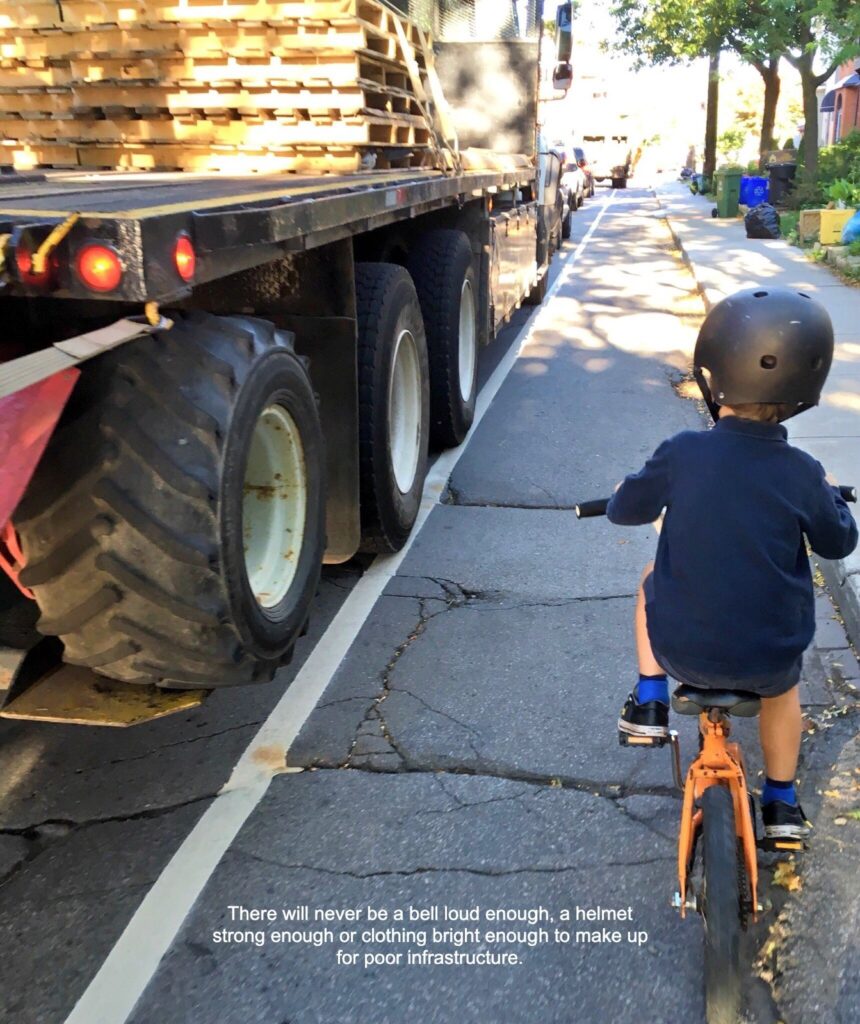
My kids grew into teenagers, and continued to walk to school ultimately to Selwyn College, although sadly by this stage they wouldn’t let me join them.
One of them tells me (on an ongoing and daily basis) that the traffic including container trucks continues, and the number of container trucks seems to have increased.
And then I started biking into town for work. Part of the way, I rode alongside roads that the container trucks use to start their journey from the port to Glen Innes. Did it feel safe? Not really. Did I get used to it over time? Not really. Did I arrive at work and vent about it most days? Sure did.
So, one day I decided to stop venting and start investigating. Well, actually what happened is: I mentioned this to my infrastructure nerd teenager (who along the way has become increasingly informed and articulate about transport and other urban issues, and how to fix them), and he started investigating. This is what he found…
If you aren’t familiar with the area, please enjoy this map and note the unique geography of this area that’s intersected by a train line through a valley, both of which have limited crossings. It’s also worth noting that hundreds of school children use St Johns Rd to get from the Gowing Drive, St Johns Park area to travel to St Thomas Primary School and Selwyn College in Kohi.
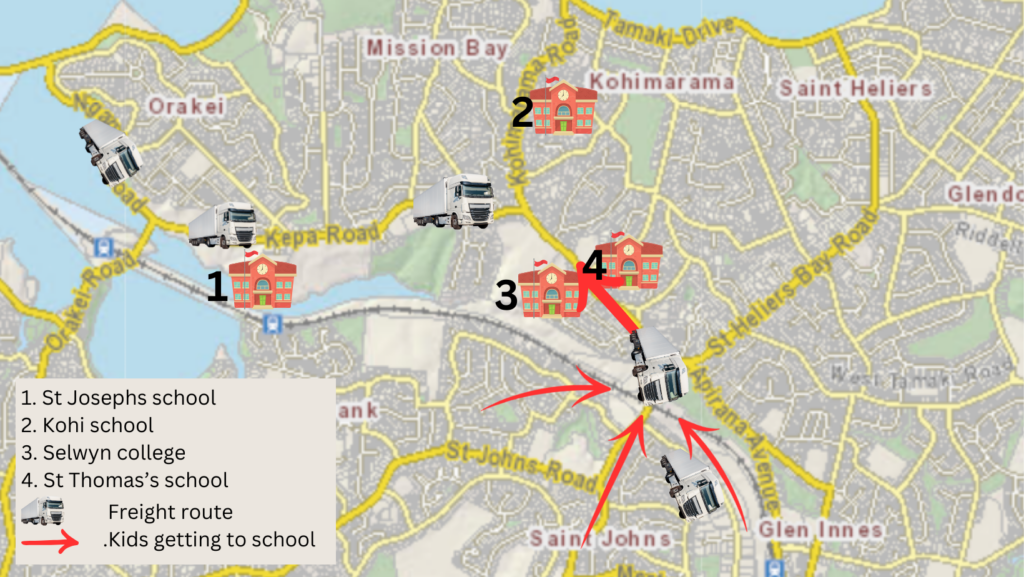
Also note that there’s no safe alternative routes along most of the St Johns Rd section children must travel to get to school. Worse, for several stretches the footpath is right beside the roadway, with no grass berm or protected bike lane (or even parked cars) to buffer vulnerable pedestrians from the rush and rumble of traffic, including hundreds of container trucks passing at 50km or more.

And here is another map, showing where all the container trucks are going along this route. The pink line shows the shortest route from the Ports of Auckland to an industrial area in Glen Innes that has container repair hubs.
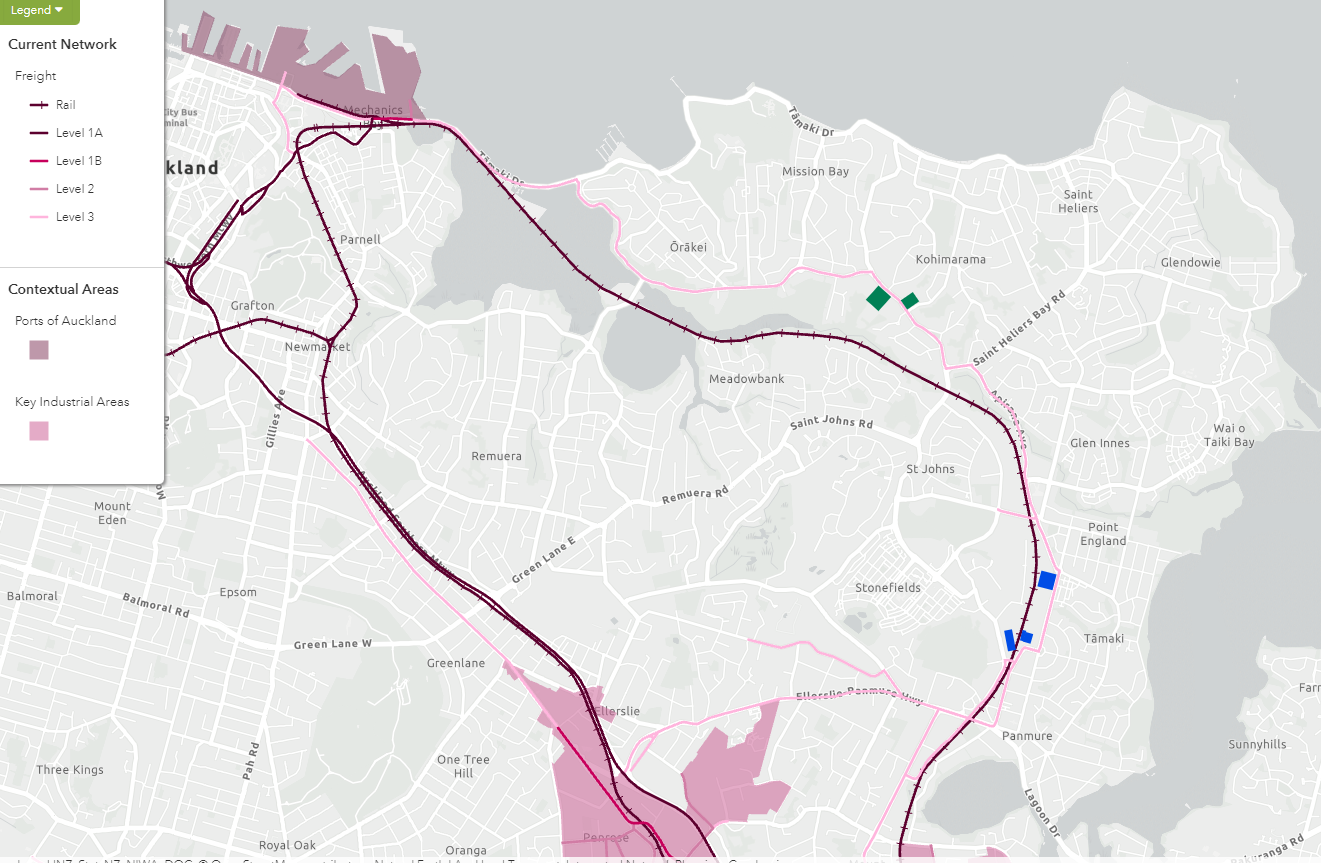
There is an alternate route, as you can see on the map curving around on the left: this would take a few minutes longer, but Auckland Transport doesn’t seem to have any way to enforce the use of this route.
This is surprising, as over the years AT has repeatedly engaged in discussion with the Local Board on the question of restricting container trucks.
The history of the call to restrict container trucks on local roads
So it turns out it wasn’t just me that didn’t like the container trucks on our local roads. The Ōrakei Local Board (OLB) had advocated to AT in their 2017 and 2020 strategic plans, asking for a solution to be found to restrict container trucks.
The 2017 OLB plan has an objective:
Advocate to AT and the Governing Body for a bylaw eliminating heavy truck and trailer units from using Ngapipi, Kepa, Kohimarama and St Johns Roads as a through-route to and from the port.
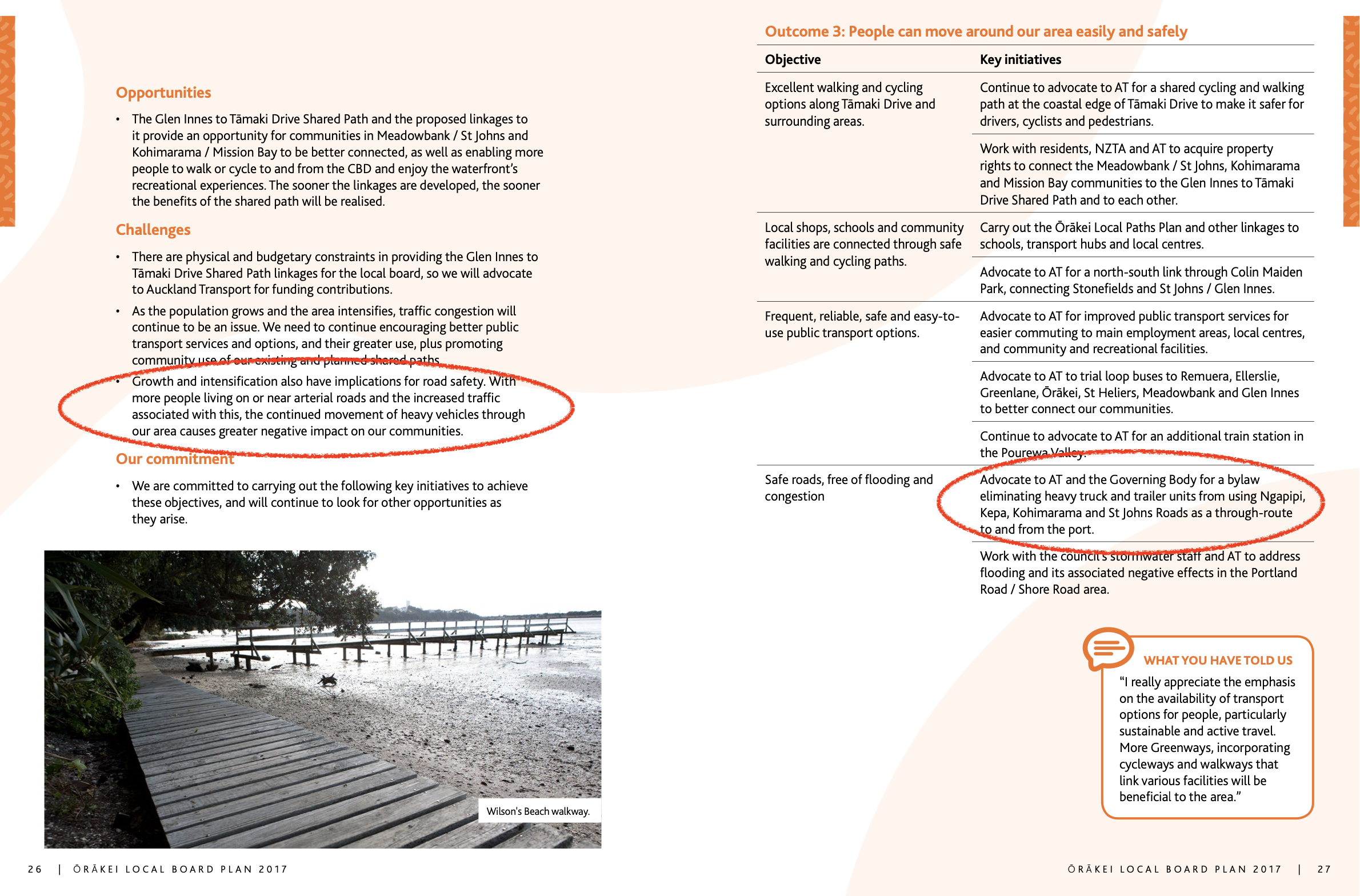
And the 2020 OLB plan has as a key initiative:
Advocate to AT and Waka Kotahi NZ Transport Agency to restrict heavy container trucks from using residential roads, to minimise safety risks to pedestrians and other road users.
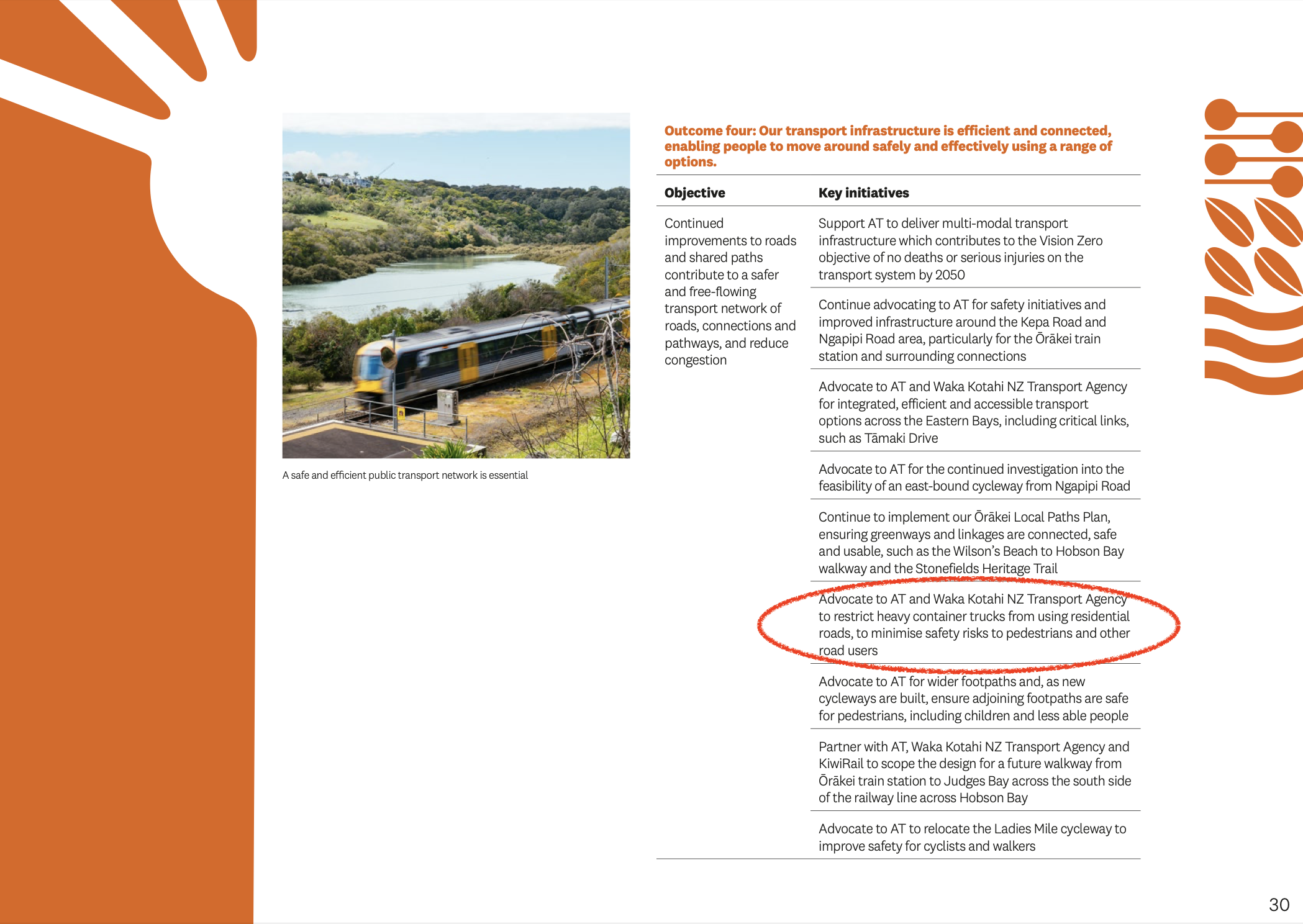
As a result of this objective being established in successive Local Board plans, Auckland Transport carried out a heavy vehicle count and presented it to the OLB in April 2022.
The gist of Auckland Transport’s October 2022 response to the Local Board
You can read the full reply from Auckland Transport (AT) here. The key points are below:
- “our data indicates that the truck volumes and safety outcomes are similar to other arterial roads across Auckland and are not at a level to present an unsuitable volume or safety risk to the community.”
- “We are aware of concerns raised regarding safety of trucks travelling through Ōrākei. However, data suggests that there is not a higher safety risk or concern when compared to similar roads.”
- “we can only apply a restriction to all vehicles in a class – so any ban would also apply to trucks serving the area (such as construction trucks for residential developments and the trucks bringing food to New World at Eastridge) as well as those travelling through the area”
Looking at these points in more detail:
- It’s interesting that AT compares this arterial route to others in Auckland, and describes it as similar.
- While there are ‘guidelines’ for arterial routes (Engineering Design Code: Urban and Rural Roadway Design, page 30) that describe e.g. the width of the road, etc – none of these guidelines is met on the Ngapipi/ Kohimarama/ Kepa/ St Johns Rd arterial route.
- Comparing some arterial road widths at their narrowest constraint: Ngapipi Rd 7.5m, Kepa Rd 8.3m, Massey Rd 10.8m, Stoddard Rd 11.5m, Browns Rd 11.6m
- … raises the question: are there any other arterial routes in Auckland as narrow as this one in the Ōrakei Local Board area, and that run through such heavily residential areas and past so many schools? I can’t think of any.
- AT says ‘we can only apply a restriction to all vehicles in a class’ – and yet, there is currently a sign at the intersection where trucks turn out of the port restricting them from using this particular route overnight. So, clearly it is possible to apply restrictions.
Where are all the containers going?
It’s funny that I had never really considered where all these container trucks were going until one day I followed one on my e-bike as it left the port heading for Glen Innes. And then once I had a visual of all of the containers, I did some research…well actually my son did some research.
Following AT’s heavy vehicle count in April 2022, the Jellicoe Container Park opened at the end of 2022. Also since AT’s heavy vehicle count, CRS container repairs closed their other hub in Auckland – meaning potentially all containers are now going to the Morrin Rd hub.
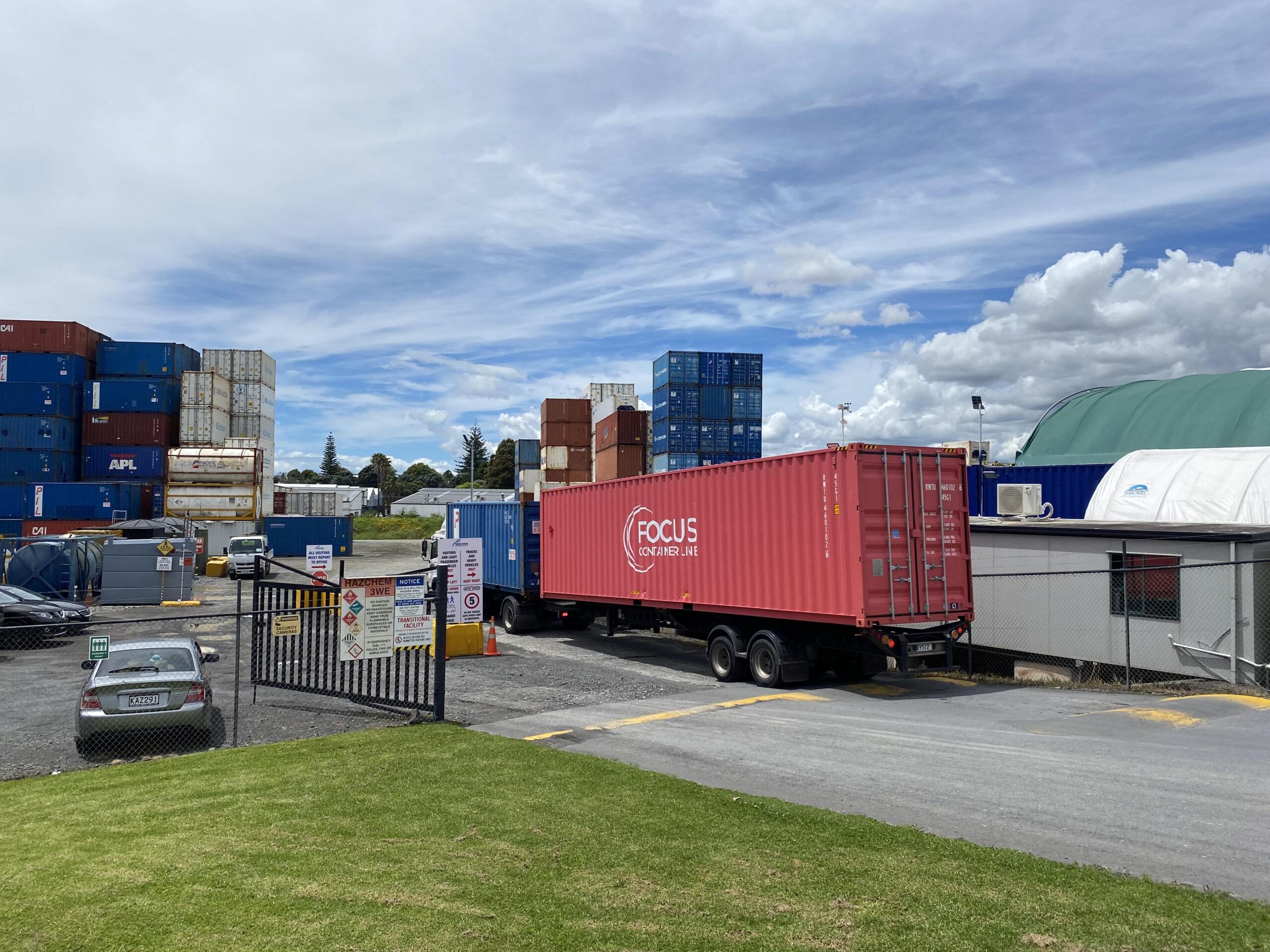
So, as of 2024 there are now three container sites around Morrin Rd/Jellicoe Rd: CRS container repairs, ContainerCo and Jellicoe Container Park. Whereas when the 2022 count was done there were two, and one of them had its containers split across another site.
In other words, now there are potentially twice as many container trucks on the route than when AT did the count in the start of 2022.
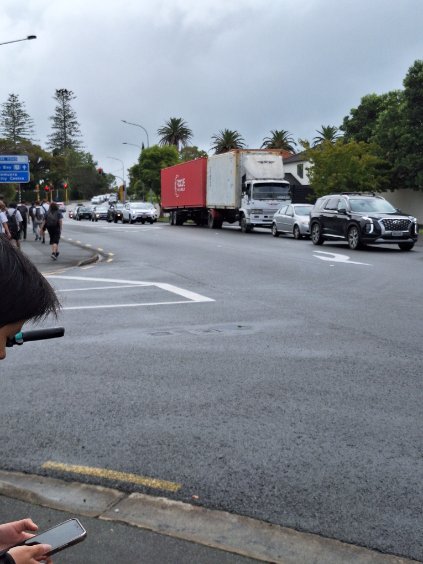
An update from Auckland Transport in 2024
In March 2024, my son and I gave a presentation to the OLB, which was then forwarded to AT. SInce then, emails have gone backwards and forwards to AT via the OLB transport representative.
In May 2024, we received this response from Auckland Transport:
Traffic Data
We have looked at the latest data (either 2022 or 2023, as AT can’t afford to do counts in all places each year). And what it shows is that traffic volumes along Ngapipi, Kepa and Kohimarama are all fairly stable.
- Ngapipi had peak hour traffic volumes of 1,431 (AM) and 1,315 (PM) in 2019. It had peak hour traffic volumes of 1,459 (AM) and 1,396 (PM) in 2023. Heavy vehicles (across ALL heavy vehicles, including containers) made up 6% of the traffic in 2019 and 7% in 2023.
- Kepa had peak hour traffic volumes of 1,909 (AM) and 1,894 (PM) in 2019. It had peak hour traffic volumes of 1,728 (AM) and 1,925 (PM) in 2022 (latest count). Heavy vehicles (across ALL heavy vehicles, including containers) made up 3% of the traffic in 2019 and 4% in 2022.
- Kohimarama had peak hour traffic volumes of 2,102 (AM) and 2,279 (PM) in 2019. It had peak hour traffic volumes of 2,095 (AM) and 2,303 (PM) in 2022 (latest count). Heavy vehicles (across ALL heavy vehicles, including containers) made up 4% of the traffic in 2019 and 7% in 2022.
While Kohimarama has had an increase, the fact that the others haven’t demonstrates that it is likely heavy vehicles coming from the south, not via the Port (otherwise they would show up in the other road datasets).
Also to note that AT do not enforce moving vehicles (we have dispensation to monitor bus lanes only). Our main enforcement task involves parking issues. We have no legal ability to enforce the “no left turn” from the port.
Given the above, we remain of the view that the heavy vehicle volumes have not significantly increased, and remain consistent with expectations for roads of this nature.
I mulled over this reply from AT… a lot! By this time, I was dreaming about container trucks, and my son and I spent much of our day discussing them!
And then I got out my calculator and turned those percentages into actual numbers of heavy vehicles, and that’s when it got interesting.
The actual number of heavy vehicles on Kohimarama Rd has increased from 84 to 147 heavy vehicles in the morning peak, which is a 74.5% increase.
Counter to the claim in that last email from AT, this does seem like a significant increase – and something that should maybe be a concern for AT. It is definitely a concern for me. And these numbers don’t even take into account the increased number of container sites since 2022.
This safety issue has been concerning me and impacting my community for 10 years – long enough for my children to grow from little kids into self-propelled young adults, with one of them spearheading the research on this issue.
Will it take another 10 years for AT to recognise it as a problem, and find a solution? Will the traffic on this already heavily congested route eventually grind to a halt with increased container traffic, which in turn causes people not want to let their children walk to school combined with overcrowded school buses leading to parents driving children?
Will a solution happen within my lifetime, or my children’s, or their children’s? Let’s see.
Update: since writing this post, I’ve been invited to meet with AT. I’m curious for readers’ thoughts and experiences: what else would be useful to ask or share with AT, when we meet?
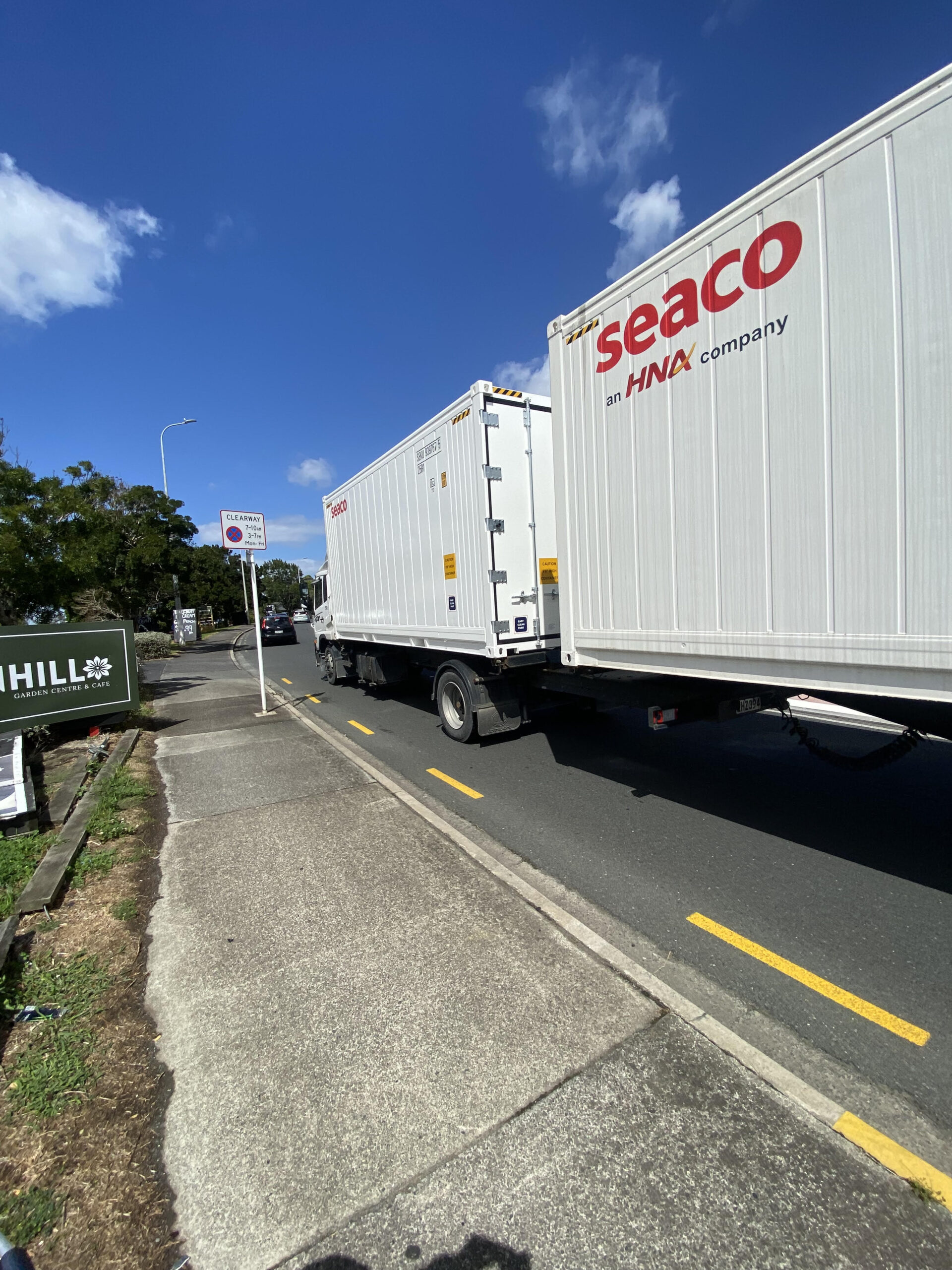

 Processing...
Processing...
I would not believe a word that AT says. I had a discussion with them a few years ago over the simple matter of repainting some yellow lines on a small section of a no exit street.
Their first response contained 3 pieces of information – none of which were correct. By the end of the day I had proven that they were incorrect.
Their information system was so bad that they could not even establish whether or not the lines – which had been repainted within the previous month, had actually been done by an AT contractor.
Another reality created by the long term abandonment of our rail network. Trucks and the trucking industry are winning, and our railways are only now being treated respectfully, although very much limited to their passenger carrying potential in the Greater Auckland area.
I grew up biking and walking to school, in a different area, but a relatively privileged suburb. Now famous for being one of the zero bike infrastructure, suburban car dominated areas; in the English language: Greenlane, with little green left.
My ex lives with our kids within walking distance of their school, but they can only walk to school in a Walking School Bus. Three blocks with three road crossings is too dangerous for a seven year old.
Big vehicles are very frightening, I used to drive some medium sized trucks, but left that employment because of the worry of hurting a person.
Unfortunately the bus dominance also introduces some monstrous vehicles into our road network, but at least they feel like armoured vehicles from within, and have the advantage of actually moving more than a few persons at a time.
Cars are our city’s worst polluters, and trucks are our city’s scariest vehicles (also bad polluters in their own right); when we ride our bikes, or walk alongside traffic, we are reducing our lifespans, breathing poisonous gas, and as a parent, it is very concerning that my own parents generation will be the longest living of all time; from there we are expected to live less.
My great grandfather died in his eighties, but I will be content to make it past fifty five, if only to see if my own kids survive into their twenties.
bah humbug
Whether road or rail freight, containers will still have to be trucked to sites for storage or repair. What matters is getting the routes to those sites optimised, to avoid the serious effects described in the post.
The first thing I noticed when I pulled up the satellite image of the container depot in Morrin rd is that it backs onto the rail route from the Port .
How hard would it be to add a siding and rail the containers up from the Port ? I guess this option has been looked at and dismissed but at first glance as an unknowledgeable bystander it would get a lot of those containers off that road .
I bet $50 that this has not even been mentioned in general chat by management, let alone investigated in any detail by the business.
A lot of this will have to do with KiwiRail itself who I bet has ZERO interest in this business. KiwiRail management is only interested in bulk goods, not business like this.
Kiwirail make a siding onto their rail network an almost impossible task. Costs involved are in orbit and the process would take many many years. Plus they are very difficult to deal with, like talking to a brick wall. Trust me I have explored this exact option. Martin’s comment below is misguided. The container yard operator would love to have a siding.
While I agree with you, in this case the railway line runs right next to the container parks mentioned. It would be a simple case of building some sidings into them and investing in some mobile cranes like POAL’s yard at Wiri and voila the trucks are off the roads.
Matiu
Zero bike infrastructure in Greenlane ?
There is the off-road bike lane on Greenlane West and East between Wheturangi Rd and Ascot Ave plus the use of the Bus lane on Great South Rd.
Not a lot but not zero
Great post thanks Charmaine, and excellent research, Dylan.
There are Vision Zero-savvy staff at AT However, the dire decisions and answers you are being given is a result of a huge safety vacuum at management level.
There should be separation and protection for all people walking and cycling from motor vehicles travelling faster than 30 km/hr and from very large vehicles like these trucks at any speed.
Question: Why do we have a safety crisis?
Answer: Because when challenged about unsafe situations like this, AT replies, “safety outcomes … are not at a level to present an unsuitable volume or safety risk” and “data suggests that there is not a higher safety risk or concern when compared to similar roads.”
Unfortunately, such replies are no longer a surprise. It’s a systemic problem at the organisation.
Having seen a container truck punt a parked car some metres onto the footpath on Stanley Street, I can tell you that physics is real, and nowhere on the road or footpath is safe from that much mass.
We should have all trucks, container trucks off the road from 7 am to 10 am and 4 pm to 7pm
Delivery to supermarkets construction sites must happen in the night time See how smoothly transport runs in Dubai and Singapore Learn and apply in Auckland Wellington Christchurch and Hamilton and see a win win situation for all
Make sure that any Time Of Use Charge includes trucks operating on this corridor between the Port and container facilities so that they are not incentivised to leave the Motorway if that is charged. The problem could get worse! Also advocate that large trucks should be charged at least three times the car fee rather than the pathetic multiple of 2 currently on our toll roads.
The Minister is “banging on” about the enormous productivity savings by cars travelling faster everywhere it seems (will car parks be next?). Why aren’t those benefitting from these wondrous savings footing the bill, or at least some of it?
London’s use of ULEZ (all polluting vehicles) and LEZ (HG vehicles) ensures that pollution monsters stay outside of the city on the M25.
NZ government Inc needs to grow some balls and introduce a similar scheme across the country. The amount of polluting vehicles of all classes on our roads is terrible.
We are a developing nation in this regard and must be easily the bottom of the OECD in this area.
Time for government to put in place some kind of scrappage scheme to help the poor get away from their 80s/90s/early 00s Aussie and Jap import high emissions machines.
On a related note we see a lot of trailer units parked on roadsides – often for days at a time – just free storage I suppose. Another use of road space that is becoming common out West is mini storage trailers parked on road sides advertising storage units and trailers. All reducing visibility, safety and by allowing this makes it more difficult to allocate space for other options like Bike Lanes.
Orakei Road is also routinely used as a rat run by large trucks accessing the port. With cars parked on either side of the road, the road narrows to less than 7m in places. Like Ngapipi / Kepa, the narrowness of the road combined with tight corners make it impossible for trucks to take corners without crossing the double yellow centre line, let alone safely pass cyclists.
Another thing to note is that the largest trucks, HPMVs aren’t allowed on most local roads – https://www.nzta.govt.nz/assets/Commercial-Driving/docs/full-hpmv-network/Auckland-Transport-approved-full-HPMV-Network-routes-July-2024.pdf. It would be interesting to know if HPMVs driving on unapproved roads is a problem or not and who enforces this.
Put cameras in Rat runs and watch the rats disappear. Normal in most British cities and towns.
Charmaine another issue to raise is the queues of container trucks on Morrin Road waiting to get into the container yards. When it happens it can stretch over a km and it is very dangerous as the road is narrow with those trucks backed up. And with the significant residential development in Morrin Road underway it is likely there will be significantly more pedestrian and bike traffic to come. Apirana Ave through Glen Innes is now way too narrow following recent roadworks and changes to road layout for even buses let alone container trucks. So that route will (or should be out of bounds) which will probably mean the traffic moves to College Road. On that basis Stonefields primary school should be added into your map of schools.
I used to ride to Selwyn College in the 60s. I could go either way (St John’s Rd or Kepa Rd) and had virtually no problems with vehicles. I do remember cycling into the wind on Kepa Rd was probably the worst problem
I am still riding 60 years later, and had a go riding along St Helier’s Bay Rd past Selwyn College. That was my one and only time. It is just ridiculous, not only container trucks, but Suburban Tractors. So many vehicles, such narrow roads, such inconsiderate drivers.
St Johns Rd is much the same… Narrow, so much traffic, everyone thinks you are in their way, so impatient.
Yes I try to give that whole area a miss…
So good luck Charmaine, all kids should be able to cycle to school without danger
Great post Charmaine. I drive and bike through here a lot and the congestion from those trucks is real – even when they get to the container yard in Panmure / Mt Wellington you can see huge queues. Simply put I do not believe St Johns Road, Kepa Road are built for so many trucks but this is the fastest shortest route so every driver will take it as they’re paid per unit delivered. Another factor that really worries me is the skill / risk taking of these truckies – typically I think there driving is of a lower standard than most driving professionals I see around Auckland.
That industrial area was surely serviced by rail in the past and is likely the reason it exists as an industrial area? It would be interesting to hear if these businesses use rail and reason why they aren’t using it more.
AT defines lane widths for arterial and collector roads as 3m to 4m.
https://at.govt.nz/media/341980/ATCOP-Section-7-Road-Layout-And-Geometric-Design.pdf
Ngapipi and Kepa are certainly local freight routes, so will always have trucks and other heavy vehicles.
Those are the standards AT applies to other people, not themselves.
It’s a matter of will. Maybe the 3rd line rail is required sooner rather than later, but maybe a small freight transfer site could be built in Tamaki right by the rail line probably where it was historically. Design it carefully so all the industrial there can use it without driving in residential areas etc. This site though is perhaps destined in the long term to be high-density residential with industrial moving further south as it is already.
Either way, containers can surely be shifted via rail for repair, maybe in a Drury site.
No, it’s a case of KiwiRail not giving a s**t about non bulk goods. To much effort for them.
Kiwirail basically don’t want sidings on their network unless its a massive operation. The line it connects to is predominantly serving passenger trains on regular intervals. To achieve a siding on this line requires massive infrastructure and huge costs. Does not make sense unless you have a very significant industrial complex. Little sidings into local industrial complexes are non existent now.
Agree with AT on this one and don’t blame them for putting it in the too hard basket. They are correct it’s really not that different to other areas every school on a major road deals with trucks rolling through all day long. I would invite the people on here suggesting to just ban trucks between certain hours to carry the full burden of the increased costs associated with that. In Brisbane and Sydney huge container trucks fly down major arterials at 70-80k and yes gasp between 7-10 and it’s not really an issue. Trucks on the road pedestrians on the footpath yes it’s not pleasant to be a pedestrian but what are we going to do we can’t just stop the economy because it’s unpleasant. Yes I’m aware of the safety issues with trucks parked along Morrin road which imo is the actual safety issue here not the perceived one because it’s “not nice” to walk near trucks which I fully accept is the case but do not accept there should be any intervention.
So – put it in the too hard basket, as you say? Together with climate change, road deaths, mouldy and expensive rentals, and all the other things where we have somebody saying “But think of the economy!”? Sod that. a government needs to think of more than “the economy”. They are not a corporation, despite what some CEOs think.
Yes, we are in 2024 not 1924. We have advanced enough that we can improve things. Separate modes as much as we can etc. Pass laws to exlude unwanted modes in certain places at certain times.
“It’s not really an issue” so sayth someone who clearly doesn’t rely on walking through such hostile urban environments to get where they need to go.
The privilege of the well-off cagers who look down on pedestrians as second class citizens. Because who cares if a supermarket trip takes me 2 hours there and back again and if my life expectancy is being slashed by the stress of nearly being run over and breathing in exhaust and tyre pollution. Speed User here is clearly worth more than me because they drive a car.
“I fully accept is the case but do not accept there should be any intervention”
Pretty much sums up your position on anything that might consider other users of a route.
Perhaps they should set up a little micro container hub around the old Tamaki station location so they could be railed there, surely this is possible.
I don’t particularly want containers going along my local EP or Mt Wellington Highways from the motorway either but that would be better than through the route explained in the post
We live in a country where economic activity literally measured in truck movements.
https://www.anz.co.nz/about-us/economic-markets-research/truckometer/
“Govt unveils $32.9b for roads, rail, public transport”
https://www.stuff.co.nz/politics/350400382/govt-unveils-329b-roads-rail-public-transport
Well, it would be interesting if they actually unveiled a big pile of cash. Because I don’t know where they want to get that funding from. Maybe cancel a few bikeways and safety projects a few hundred times each, that will raise the money?
Right on!
“Walking and cycling funding halved in govt’s transport programme”
https://www.rnz.co.nz/news/political/526837/government-to-spend-nearly-33-billion-on-transport-over-the-next-3-years
Yeah, funny he calls walking (and cycling) “nice-to-haves” when every driver becomes a pedestrian to finish their walk to any destination.
From that article:
“In response to whether it was fair that walking and cycling funding had been halved, Brown said a lot of money had been spent on “nice-to-haves” and the new programme was about “getting back to basics” and focussing on road maintenance.”
“There’s less money going into cycleways, and I think New Zealanders are sick and tired of the amount of money going into cycleways.”
What a joke, it was and has pretty much always been peanuts. Such a media line to keep saying that to keep lots of people happy when the reality is even making it zero would be nothing in the grand scale of the whole budget. It would hardly give you 3 m of a “road of national significance”…..someone might want to get the calculator out and give us a figure for that.
When I see how techbros (and certain technology/speed fixated commenters here) talk about the future sometimes I wonder if they genuinely do want to do away with walking alltogether and are espousing a WALL-E type future (or those god-awful AI ads) where we’re all in hoverchairs and literally never walk.
I mean, that trope even shows up in the 1956 automotive industry propaganda cartoon ‘Your Safety First’.
Simple solution: Drive-throughs!
Great article. Live locally so totally appreciate the concern. Have also seen utes go up on the pavement to cut inside to avoid the queue turning right to go to St Heliers. That new Gull station has also definitely changed things in terms of traffic crossing the footpath.
There is possible mitigation by building the connection from Gowing Drive to the cycle path but this has been continually pushed back every LTP round. Otherwise that stretch of road from Gowing Drive to John Rymer Place is an accident waiting to happen.
Sounds like AT is struggling with what to do when stroads are no longer acceptable to locals.
Great work Charmaine and son! I hate riding on these roads now the heavy truck traffic has increased. I simply take to the footpath whenever a truck approaches. It’s not ideal!!! I love the idea of restricting heavy truck between school hours although increased night time traffic may not be appreciated by residents.
Lastly, the local board put money into the kitty for the Gowing drive link to the shared path years ago, which should have been built when the path was. NZTA and AT spent the money elsewhere (probably fixing their orakei basin path handrail cock up). Once we get the gowing link things will be much safer and easier for many school kids